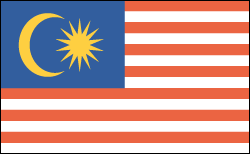Malaysia
| Next |
| Facts & Figures | |
|---|---|
Head of State: Tuanku Mizan Zainal Abidin ibni al-Marhum Sultan Mahmud (2006) Prime Minister: Datuk Seri Najib Tun Razak (2009) Land area: 126,853 sq mi (328,549 sq km); total area: 127,316 sq mi (329,750 sq km) Population (2010 est.): 26,160,256 (growth rate: 1.7%); birth rate: 22.0/1000; infant mortality rate: 15.3/1000; life expectancy: 73.5; density per sq km: 76 Capital and largest city (2003 est.): Kuala Lumpur, 3,688,200 (metro. area), 1,403,400 Other large cities: Kelang, 683,200; Johor Bharu, 682,100 Monetary unit: Ringgit |
| ||
|
Geography
Malaysia is on the Malay Peninsula in southeast Asia. The nation also includes Sabah and Sarawak on the island of Borneo to the east. Its area slightly exceeds that of New Mexico.Most of Malaysia is covered by forest, with a mountain range running the length of the peninsula. Extensive forests provide ebony, sandalwood, teak, and other wood.
Government
Constitutional monarchy.History
The ancestors of the people that now inhabit the Malaysian peninsula first migrated to the area between 2500 and 1500 B.C. Those living in the coastal regions had early contact with the Chinese and Indians; seafaring traders from India brought with them Hinduism, which was blended with the local animist beliefs. As Muslims conquered India, they spread the religion of Islam to Malaysia. In the 15th century, Islam acquired a firm hold on the region when the Hindu ruler of the powerful city-state of Malacca, Parameswara Dewa Shah, converted to Islam.British and Dutch interest in the region grew in the 1800s, with the British East India Company's establishment of a trading settlement on the island of Singapore. Trade soared, with Singapore's population growing from only 5,000 in 1820 to nearly 100,000 in just 50 years. In the 1880s, Britain formally established protectorates in Malaysia. At about the same time, rubber trees were introduced from Brazil. With the mass production of automobiles, rubber became a valuable export, and laborers were brought in from India to work the rubber plantations.


No comments:
Post a Comment